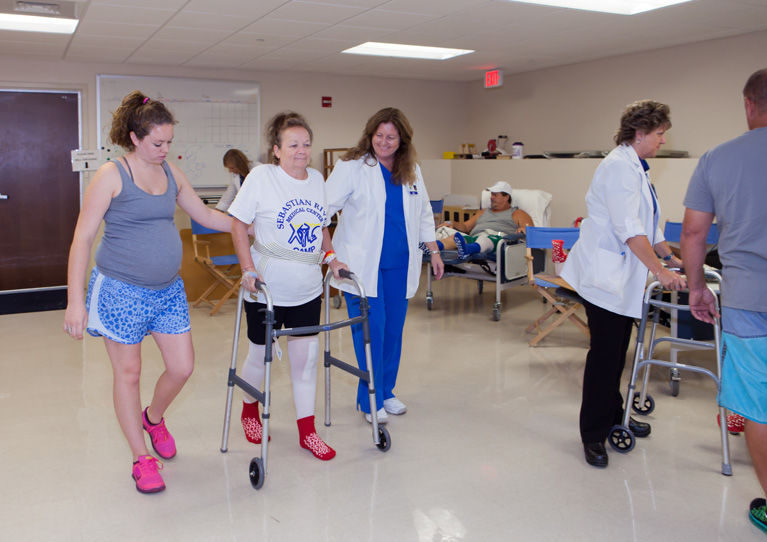
If you’re having, or thinking about having, a total knee or hip replacement procedure, you’ve got a great deal of company.
The Centers for Disease Control and Prevention projects that 719,000 knees and 332,000 hips will be surgically replaced in the U.S. this year alone. The American Academy of Orthopedic Surgeons, (AAOS), says that by 2030, knee replacement procedures will exceed three million annually.
That may be something of a bonanza for orthopedic surgeons, but unless those hip and knee replacements are followed-up with competent physical therapy treatments, the surgeries may be far less successful than most patients imagine.
That’s why Bernadette Haugh and Lisa Cox want anyone considering such a procedure to think about enrolling in Sebastian River Medical Center’s orthopedic CAMP, which is an acronym for the “Center for Accelerated Mobility and Performance.”
For Haugh, SRMC director of rehabilitation, and Cox, the hospital’s director of medical-surgical services, the reason for the post-operative camp is a simple one. “We’ve learned,” Haugh explains, “that movement is our friend.”
The AAOS puts it more bluntly. It says proper post-op exercises, ”are essential for increasing circulation…to prevent blood clots,” and adds that those exercises are also, “vital to help strengthen muscles,” in both hip and knee patients. The Mayo Clinic agrees, stating flatly that, “Activity and exercise must be a regular part of any knee or hip patient’s day in order to regain the use of their joints and muscles.”
Why? Because while the number of hip and knee replacements keeps growing, both are still major surgeries.
In a hip replacement procedure or “total hip arthroplasty,” doctors surgically remove the hip joint and replace it an artificial version or prosthesis which is usually made of metal and plastic components. Put your hand on your hip. There’s more than just a little bone and cartilage there that must be surgically removed before the prosthesis can be placed and muscles re-attached.
Similarly, in a knee replacement or knee arthroplasty, as the Mayo Clinic explains, “A surgeon cuts away damaged bone and cartilage from your thighbone, shinbone and kneecap and replaces it with an artificial joint made of metal alloys, high-grade plastics and polymers.”
Whether all that is done by traditional surgical techniques, newer minimally invasive procedures or robotic surgery, it’s still a major shock to the body and physical therapy is the only proven way to acclimate patients to the enhanced mobility these replacement surgeries can offer.
In both knees and hips, osteoarthritis is the primary source of the pain that causes so many to end up in operating theaters.
Osteoarthritis “occurs when the cartilage covering the ends of the bones where they meet to form joints breaks down. This causes the bones of the joint to rub together. Growths of bone, called spurs, may form around the joint and lead to pain and stiffness,” according to National Institutes of Health.
There are other possible causes of hip or knee damage – including sports injuries, fractures, bone tumors, rheumatoid arthritis and osteonecrosis – all of which lead to pain, inflammation and the general destruction of the joint, but osteoarthritis is by far the single most common cause of both knee and hip pain leading to replacement surgeries.
Whatever the cause or causes, SRMC learned over a decade ago that proper physical therapy is essential in helping patients recover. With good physical therapy, patients can usually meet and exceed the level of mobility and flexibility they had prior to their surgeries while no longer suffering pain.
SMRC has also learned that making physical therapy more fun goes a long way towards helping recovering patients want to participate more fully. To that end, each participant gets a tee shirt, a hat and a tote bag to enhance the “camp” feeling and family members or “coaches” are actively encouraged to get involved.
The primary orthopedic nurse for the program, A.J Glaser, has been involved with ortho camp, “since day one” and Cox is quick to point out how popular he is with the program’s “campers” including the over 160 patients who participated last year.
As one anonymous comment card put it, SRMC’s ortho camp is, “the most fun you can have after having major surgery.”
While this particular camp has no tents, no bugs and no lumpy sleeping bags, it does have a strong commitment to promoting safety, helping patients avoid infections and blood clots while re-learning movement skills for maximum mobility.
Better still, there are no additional charges on the hospital bill for participating in the Center for Accelerated Mobility and Performance program, and Glaser, Haugh and Cox have one more trick up their respective sleeves. While physical therapy begins the day after surgery, the staff helps patients get fully dressed prior to starting. There are no hospital gowns at this camp and that, says Cox, helps people get started sooner on the road to full recovery.
The program offers three or four days of in-hospital therapy and three to eight weeks of outpatient rehab, all of which is included in the hospital’s basic charge for the patient’s surgical stay. You can elect NOT to take advantage of “camp” if you like but you’ll still pay the same for your knee or hip replacement.
In-home rehabilitation, which also may be recommended, is not included in the program, and must be paid for by patients or their insurance companies.
The Sebastian River Medical Center’s orthopedic camp is at 13695 U.S. 1 in Sebastian. The phone is 772-581-7905.



